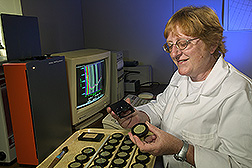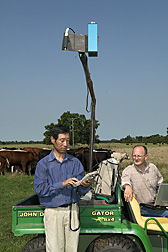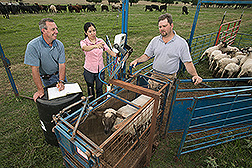A Quick Way To Gauge Forage Nutrition
Real-time method tells whether the grasses livestock feed on are at their peak.
|
|
Imagine knowing, almost immediately, how much nutrition a calf is getting from the grass it’s grazing on—or even how much weight it’ll gain if it keeps eating that particular grass.
That may one day be possible, thanks to spectral reflectance studies at ARS’s Grazinglands Research Laboratory in El Reno, Oklahoma.
Complete development and commercial use of this technology are at least a few years away. But an important step toward that goal was taken recently when the ARS laboratory established a cooperative research and development agreement (CRADA) with two Oklahoma firms. Under it, the firms will design and develop a small, hand-held, low-cost optical remote sensor that can be used in the field to calculate, store, and display data on a forage’s nutrient quality.
“A critical shortcoming in grazingland management is an inability to measure—in real time—the nutritional value of live, standing forages on pastures,” says soil scientist Patrick Starks. “This information is needed to make informed land- and livestock-management decisions about stocking rates, beginning and ending dates for grazing, and feeding of supplements. Spectral reflectance shows great potential for eliminating this problem.”
|
|
Starks, who’s in the Oklahoma facility’s Great Plains Agroclimate and Natural Resources Research Unit, animal scientist William Phillips of the lab’s Forage and Livestock Production Research Unit, and Samuel Coleman of ARS’s Subtropical Agricultural Research Station in Brooksville, Florida, have already demonstrated that spectral reflectance data can portray quality of forage grasses with accuracy comparable to conventional lab analysis.
The important difference is that spectral reflectance data can be processed in seconds. Current analysis methods entail clipping, near-infrared spectroscopy, and chemical procedures that, while accurate and site-specific, are laborious and take days to complete.
“There are huge potential benefits to this technology,” says Starks. “In addition to reducing manual sampling, it can lead to nutritional landscape mapping and more efficient pasture management and supplement feeding.”
Starks says these studies may prove most valuable in tipping growers off as to when or whether forage supplements are needed. “We’re talking about performing precision supplementation.”
Lead Time for Decisionmaking
Starks points out that growers currently assume that bermuda-grass’s protein content is high at the start of the growing season and remains so for 6 to 8 weeks; then supplementing is needed. “We want to know whether spectral reflectance can give us an earlier warning if nutrient quality of that grass is falling off,” says Starks. “This would give us lead time for decisionmaking and an insight into when to start supplementing.”
Adds Phillips, “This technology can give grazing managers early warning of nutrient deficiencies and can also be used to harvest hay at a desired quality level. Grazing managers could use it to move cattle to various pastures to capture forage at its highest quality.”
Remote sensing collects data by detecting and measuring reflected or emitted light, heat, sound, and radio waves. In this study, data was collected in the field with a hand-held commercial hyperspectral radiometer, which is a portable, lightwave-reading machine that was positioned to sample 0.6-square-foot swaths. The scientists used the equipment to scan plants and estimate their digestibility through analysis of 252 wavebands of the electromagnetic spectrum.
Under the CRADA, a basic instrument that could one day make this technology widely available is being developed by former ARS scientist Frank R. Schiebe, who is now president of Durant Design and Development, in Durant, Oklahoma. Assisting him is Dewain Davis, president of TerraVerde Technologies in Stillwater, Oklahoma. The CRADA calls for Davis’s firm to manufacture and market the device once it’s fully developed and evaluated.
The research at El Reno focused on bermudagrass, Cynodon dactylon, alone and with a scattering of senescent downy brome, Bromus tectorum, and yellow bristlegrass, Setaria glauca. It compared how conventional and real-time data-collecting methods detected concentrations of nitrogen and other components.
Forage crops and native rangelands are vital to U.S. livestock interests, since they’re the main feed staple of all ruminant animals tied to the meat and dairy industries. With the exception of animals being fattened on grain, most of the 100 million head of cattle and 6 million sheep in the United States depend on one of the four major forms of forage: pasture, range, hay, or silage.
Predicting Weight Gains and Growth
In addition to investigating faster forage-nutrition analysis, the work has spawned an interesting side study. Researchers found that the technology can also help predict weight gains and growth of foraging animals.
ARS animal scientist Michael Brown and Redlands Community College undergraduate student Amina Phillips monitored spring-born lambs for 3 years to see whether animal weight gains could be predicted using spectral reflectance measurements taken in pastures.
Lambs were randomly assigned to one of four, 4-acre, predominantly bermudagrass pastures so that each pasture was stocked with a dozen lambs. Spectral reflectance of each pasture was measured when initial lamb weights were taken and eight other times.
Brown says results “suggest that animal gains based on feeding on specific forages can be predicted—using 15 wavelengths of light—with reasonable accuracy.”
But the lamb study also underscored the need for investigations on animal intake and how estimates related to intake can be tied into the reflectance technology. “Once we can develop equations that accurately estimate intake based on spectral reflectance data, we’ll be able to closely formulate forage supplements,” Brown says.
“If you can determine how much the livestock are eating and the quality of the forage, you can determine their expected gains,” says Starks. “But if gains aren’t acceptable on forage alone, real-time estimates of forage quality and intake will allow us to provide a more exact supplement to the animals.”
“Supplementing grazing animals with grain or hay without regard to nutrients they receive from forage is inefficient if we overfeed or underfeed them,” says Brown. “But there are times within the grazing season that supplementation is economically efficient. So it would be a great advantage for growers to be able to evaluate the need for, and profitability of, supplements in real time.”—By Luis Pons, Agricultural Research Service Information Staff.
This research is part of Rangeland, Pasture, and Forages, an ARS National Program (#205) described on the World Wide Web at http://www.ars.usda.gov/research/programs.htm.
Patrick J. Starks, Michael A. Brown, and William A. Phillips are with the USDA-ARS Grazinglands Research Laboratory, 7207 W. Cheyenne St., El Reno, OK 73036; phone (405) 262-5291, fax (405) 262-0133.
"A Quick Way To Gauge Forage Nutrition" was published in the September 2005 issue of Agricultural Research magazine.









